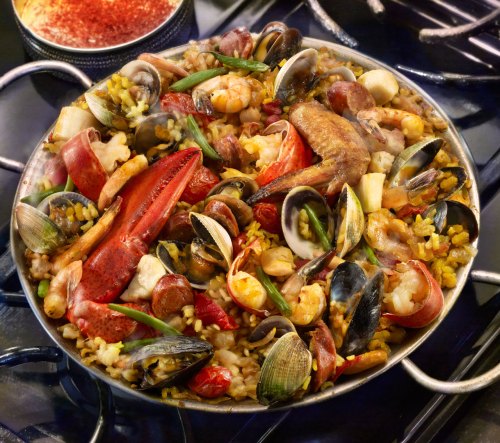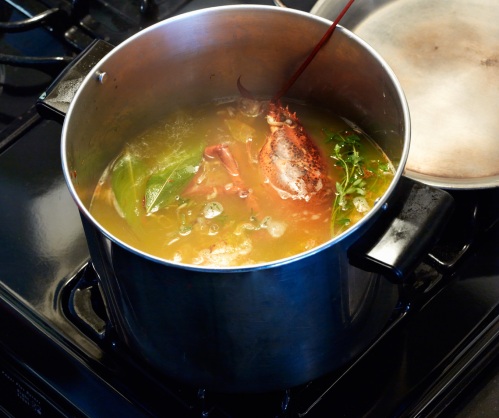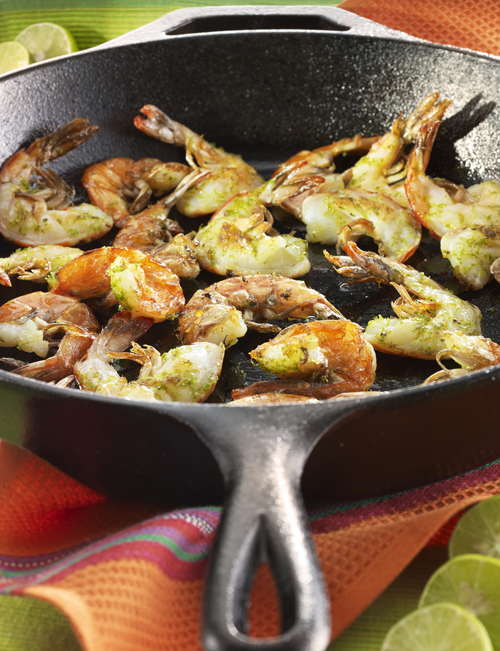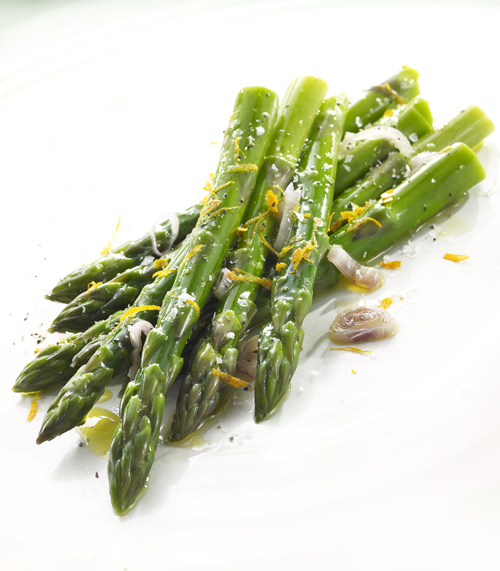The first time I had a really great paella was in Majorca Spain, where every kind of seafood available could be obtained freshly caught, having never been frozen. The flavor and texture is incomparable to our once frozen varieties. The shrimp and baby squid quite literally melted in my mouth. My Uncle Nick had an apartment there in town over looking the marina. Two friends of mine and I were visiting with him for the Christmas and New Year’s holidays. He prepared for us an incredible paella, taking no short cuts, making his stock from scratch.
In my version, seen above, I did my best to recreate the flavors and textures I remembered from Spain. I did take a tiny short cut in buying organic free range chicken stock and clam juice, which I enhanced by boiling it down with chicken wings, a lobster head, shrimp shells, a whole carrot, onion and celery stalk, a couple of bay leaves, a few sprigs of thyme, and a pinch of saffron.
My photographer friend, David, and I went to a Spanish Restaurant in NYC, El Charro Español, which specializes in paella while we were researching to write and shoot this post, and help me come up with my recipe. I ordered the seafood paella and he ordered the Paella Valenciana, which also included seafood and featured chicken and chorizo, a smoky, spicy sausage. I usually don’t eat pork products due to the high Triglyceride levels, but when I tasted what a difference it made in the flavor of David’s rice compared to mine, I was sold on chorizo in paella as a must. We borrowed a paella pan with the generosity of Luis, the owner of the restaurant. I am told that the pan can make all the difference, but that the most important thing is the proportion of the broth to the rice, and of course the flavor of the broth.
Pre-heat the oven to 450’F and place a shelf close to the bottom of the oven
Meat and Seafood Ingredients:
- 1 small live lobster-remove the head and small legs for the stock. Cut the tail into 1 inch pieces, leaving the shell on.
- 4 chicken wings, browned on both sides in plenty of canola oil in a skillet-use 2 for the stock.
- 12 tiny clams, scrubbed and sorted to ensure that they are alive (I prefer Cockles. They are ridged and have a green tint).
- 1/2 lb. medium shrimp- use the shells for the stock (and heads if you can get them that way).
- 1/4 lb. small mussels, scrubbed and sorted.
- 1/4 lb. sea scallops-cut into quarters
- 1 eight inch chorizo sausage-sauteed in the same pan with the chicken, then cut into 3/4″ inch thick rounds.
Prepare the seafood and refrigerate until you are ready to put them into the paella pan. Set aside the cooked chicken and chorizo.
Broth:
- 1 quart of organic free range chicken stock
- 1 pint of clam juice
- 1 cup of dry white wine
- 1 8 oz. can of crushed San Marzano tomatoes
- 2 chicken wings, browned on both sides as said above
- 1 lobster head
- shrimp shells
- 1 large onion, washed and quartered
- 1 whole carrot, scrubbed
- 1 celery stalk, scrubbed
- 3 bay leaves
- 3 sprigs of thyme
- 1 teaspoon crushed saffron fibers
Boil the broth ingredients until it reduces to about half of the volume, or until you need to use it. Strain out the bits and discard them.
Vegetable & Rice ingredients:
- 1/2 cup chopped onion
- 1/2 cup chopped, roasted Piquillo peppers or Italian roasted red peppers
- 1 minced shallot
- 1 tsp hot, smoked Hungarian Paprika
- 1 tsp crushed Saffron threads
- 1 tsp sea salt
In a paella pan, saute the above ingredients in olive oil over medium heat until the onions and shallots are soft and translucent. Then add in:
- 1 cup short grain rice such as Arborio or Bomba
- 1/2 cup cherry or grape tomatoes, cut into halves
- 1/2 cup of canned butter beans, drained
- 1/2 cup blanched haricot vert, cut into one inch lengths
Stir together thoroughy, then add in:
- 2- 2 1/2 cups of hot broth
Continue cooking the rice blend for about 5 minutes, stirring all the while. As the rice gets a bit thicker, start adding in the proteins from the largest to the smallest, nestling them into the rice mixture. Place the paella pan on the bottom shelf of the oven. Bake for about 20-30 minutes until most of the broth is absorbed, and the rice is just bit al dente. Cover and let rest for about 10- 30 minutes before serving. Having a crusty bottom is considered a good thing. It adds flavor and depth to the dish. Serve with lemon wedges and white or red sangria.
Also visit my Food News column The Huffington Post and my professional website at marilinda.com.
Thanks,
Marilinda








